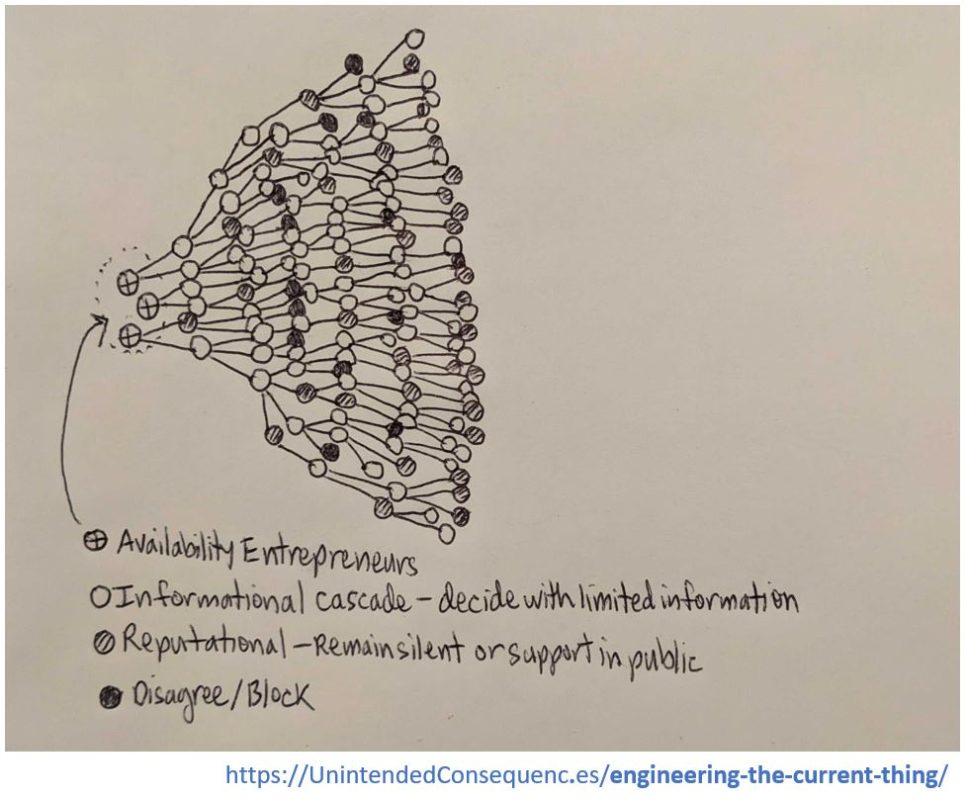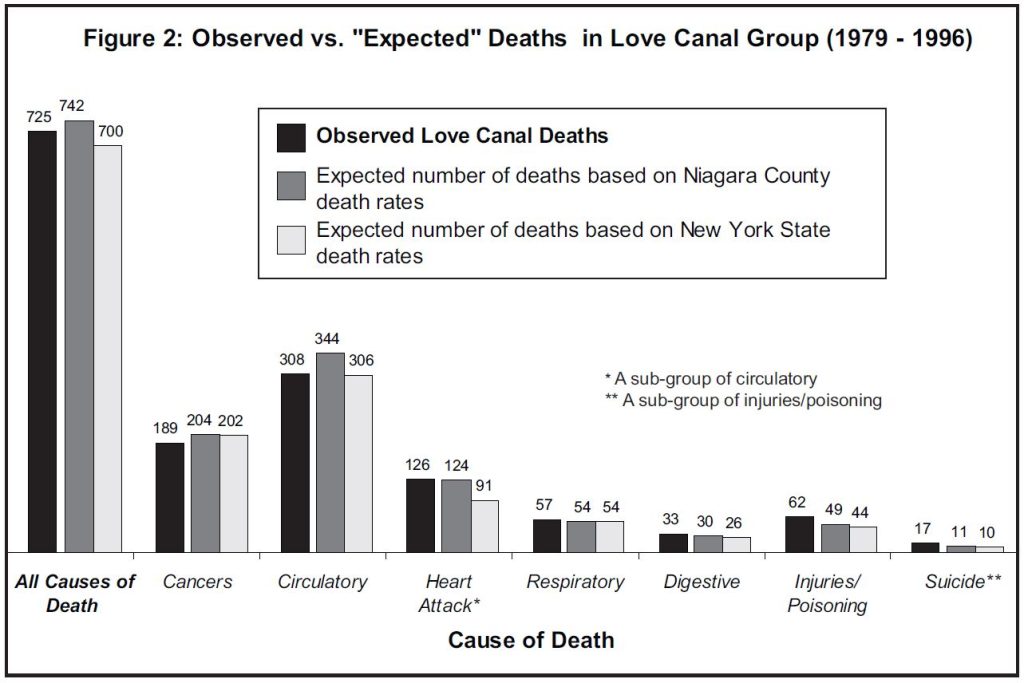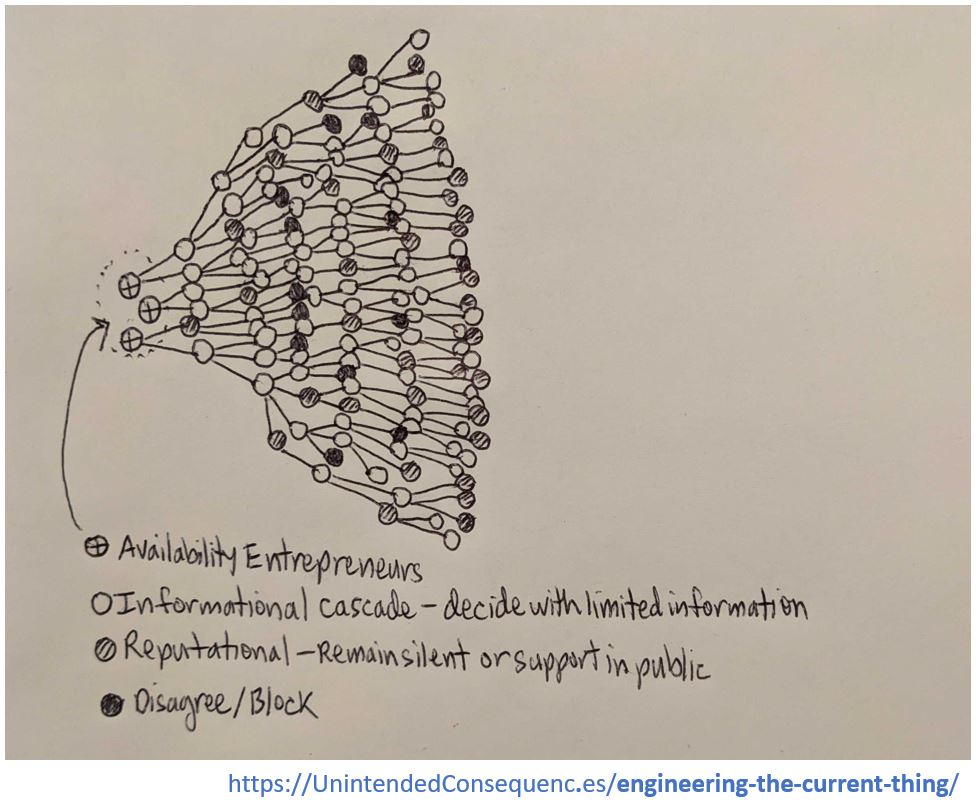If you pay attention online you might have heard of “The Current Thing.”
What’s The Current Thing? The Current Thing is any concept that grabs hold of public attention, sometimes out of nowhere, and which demands an answer: are you for or against?
I also like Marc Andreessen’s explanation.
If not supporting it gets you disinvited from the dinner party, it’s the current thing.
— Marc Andreessen 🇺🇸 (@pmarca) April 5, 2022
But where does The Current Thing come from? Does it just happen or is it made? How does it work?
And so, I read through the paper “Availability Cascades and Risk Reputation,” after Andreessen mentioned it as a seminal work on The Current Thing. Here’s how the paper begins:
“An availability cascade is a self-reinforcing process of collective belief formation by which an expressed perception triggers a chain reaction that gives the perception increasing plausibility through its rising availability in public discourse. The driving mechanism involves a combination of informational and reputational motives: Individuals endorse the perception partly by learning from the apparent beliefs of others and partly by distorting their public responses in the interest of maintaining social acceptance.”
There’s a lot in just that first paragraph. Some of the main points:
- There’s a “self-reinforcing process…” That is, a positive feedback loop.
- “Increasing plausibility through its rising availability in public discourse.” People start to hear about the current thing everywhere and therefore start to believe it.
- “The driving mechanism involves a combination of information and reputational motives…” The informational motives comes from our inability to vet all information. The reputational motives come from not wanting to appear out of synch with others.
The paper was published in 1999, but it relates well to today.
I don’t write on a breaking news cycle so I’m late to the party here. You may have already seen a common representation of The Current Thing in the form of the “NPC Wojak badge,” which looks like this (original poster currently banned from Twitter, of course).

There are even people selling t-shirts of it (Ukraine version here).

But is The Current Thing made or does it just happen? On the “made” argument is the chain reaction — a positive feedback loop — that the authors above describe as being designed. What interested me was that the positive feedback loops are engineered and without consideration of unintended consequences. The goal is not a stable system, but movement in a desired direction.
This is different than my earlier post on Morals of the Moment, where I described how focusing on what is “right” led to bad outcomes like the student loan crisis, bigger wildfires, and worse hiring practices for minorities.
“Leading with morals makes it uncomfortable to disagree with the reason for doing something. Or do you want students denied an opportunity at college? Or is it you want forests to burn? Or do you want to deny people a fair chance at employment?
“When we lead with morals we also more easily fool ourselves. I doubt that proponents of any of the policies above really wanted the outcomes their policies produced. But those paths were made smoother by believing that they were doing the right thing.”
Here are some of the main points of the paper “Availability Cascades and Risk Reputation.”
Availability Heuristic. People have limited time and limited access to information. Therefore, they need to use heuristics just to get through their day — the Availability Heuristic comes in here.
“[T]his heuristic interacts with identifiable social mechanisms to generate availability cascades… through which expressed perceptions trigger chains of individual responses that make these perceptions appear increasingly plausible through their rising availability in public discourse… Under certain circumstances, however, they generate persistent social availability errors — widespread mistaken beliefs… The resulting mass delusions may last indefinitely, and they may produce wasteful or even detrimental laws and policies.”
We can’t investigate many new claims. We can’t even access and analyze the data on many claims. What do we do instead? Take a clue from the responses we see others make and ride on their judgment. But did they make their judgments any differently from us?
Information Cascades. Incomplete information leads people to base their own beliefs on the apparent public beliefs of others.
Again from the “Availability Cascades” paper:
[When debating how to respond to a toxic spill, individuals] “want to know what will be best for themselves, their families, and their communities. Generally, however, they will devote little time to examining the scientific evidence because, if nothing else, they would not know how to interpret such data without extensive study. Most of the community’s members will form their private [judgments and preferences] through very limited information…. Suppose… the media are comparing the source of contamination to leaded gasoline, which was banned after a cost-benefit study showed it to be a highly toxic pollutant. Individuals exposed to the media are more likely… to consider the contamination as representative of high-risk chemicals, with all the associations that follow. The key precondition for an erroneous informational cascade is thus that most citizens have little reliable information of their own about the claim in question.”Reputational Cascades. “In the case of a reputational cascade, individuals do not subject themselves to social influences because others may be more knowledgeable. Rather, the motivation is simply to earn social approval and avoid disapproval.”
People make decisions on what they support or oppose based on their risk of being publicly shamed for holding the wrong beliefs.
Availability Entrepreneurs. This was the most interesting part of the paper for me. An Availability Entrepreneur is someone who understands the way the processes described above work and who then seeks to use this to their advantage.
“Located anywhere in the social system, including the government, the media, nonprofit organizations, the business sector, and even households, these entrepreneurs attempt to trigger availability cascades likely to advance their own agendas.’ They do so by fixing people’s attention on specific problems, interpreting phenomena in particular ways, and attempting to raise the salience of certain information.”
“Availability entrepreneurs try to trigger availability cascades likely to advance their causes, and they work to extend those already in progress. Acting selfishly or altruistically, they focus attention on isolated events, select information to support their preferred interpretations, and make anyone who questions their objectives appear ignorant, duped, or depraved.”
The Availability Entrepreneur launches a cascade that helps power itself, like this.

Availability Entrepreneurs use a kind of disinformation, just differently than usually described. Rather than with the purpose of harming others, the Availability Entrepreneurs start their information cascades to benefit themselves.
The paper I’m citing is from 1999, but the examples are still relevant today. Here are a couple of overblown crises the authors mention.
Love Canal
One of the US’s most famous environmental disasters in the last 50 years was at Love Canal, a neighborhood in Niagara Falls, New York. The place gained notoriety in 1976 when a chemical waste landfill from decades earlier overflowed its banks. People living in the area complained of health effects and a local resident, Lois Gibbs, organized residents to fight for cleanup, compensation, and relocation.
The name Love Canal still makes people think of toxic chemicals and corporate greed. That’s certainly the way I thought of it.
But it wasn’t the case.
From “Mortality among Former Love Canal Residents,” published in 2009 (10 years after the paper I’ve been referencing and more than 30 years after the Love Canal incident itself):
“The results did not demonstrate an elevation of overall mortality in the LC [Love Canal] cohort compared with Niagara County or NYS [New York State] from 1979 to 1996. There was some evidence of higher than expected death rates from AMI [acute myocardial infarction] compared with NYS and from external causes of injury, principally suicide and motor vehicle accidents, compared with both NYS and Niagara County.”
From “Love Canal Follow-up Health Study Mortality Community Report,” published in 2008 by the New York State Department of Health:
“The study was not able to show that the overall death rate among Love Canal residents was different than expected based on death rates seen among people of the same age and sex in both Niagara County and New York State from 1979 to 1996. However there were some differences in causes of death. For example, deaths from suicides or accidents appeared to be more common among Love Canal residents than other residents of Niagara County or New York State. The reasons for this difference are not clear, but it could reflect the effects of exposure to Love Canal chemicals or of stress on the nervous system.”

Organizer Lois Gibbs, the “Availability Entrepreneur,” is still active in environmental justice today.
Gibbs also wrote books including Love Canal: My Story, was the focus of the movie Lois Gibbs: The Love Canal Story, received honorary degrees from a number of colleges, was recipient of the Goldman Environmental Prize (1990), the Heinz Award (1998), and was even nominated for the Nobel Peace Prize in 2003.
Alar on Apples
“A salient phenomenon in American environmental politics is the ‘pollutant of the month’ syndrome. The essence of this syndrome is that expressed concerns about a particular substance fuel growing anxieties, which then generate an irresistible demand for regulation. These anxieties remain in the headlines until they are bumped off by a new perceived hazard.”
Alar was a pesticide commonly used on apples. Research by Alar’s manufacturer showed that Alar used in moderate amounts produced no increased cancerous tumors in mice, but that high amounts did increase tumor prevalence. The Natural Resources Defense Council (NRDC) then extrapolated these findings with the expected outcome that “between 4700 and 6200 preschool children, or about one out of every 4200 exposed to Alar, will develop cancer by age six.”
That’s a terribly high number and 60 Minutes ran a piece with a skull and crossbones apple.

The problem was that the NRDC’s assessment wasn’t accurate. The EPA later revised the risk down by a factor of about 60 to one in 250,000, which later was again revised as less risky by the UN. According to research by Consumer Reports, the human lifetime cancer risk was reduced by another factor of 20 to only five cases per million, well within the safe range. But the Alar craze had already run its course and the pesticide removed from use.
(I earlier wrote about Radon gas, another pollutant of the month, in Fear, Fury, and Forgetting.)
Proposed Antidotes
I liked the paper, but it ended with an odd recommendation — the creation of a central Risk Information Site (RIS) online — to be operated by a nongovernmental Risk Information Center (RIC). The RIS would then list risks of products and events that concern the public.
This recommendation makes me wonder how much the paper’s authors believed their own analysis. One of their points is that people don’t seek out more complete information themselves and instead take informational shortcuts and seek to shield their reputations.
I don’t see how the RIS would make a difference but I can also see that in 1999, when the paper was written, the Internet looked different.
My Antidotes
I believe we should see the worst Informational and Reputational Cascades among people who must often give their individual views publicly. That is, celebrities in fields such as media, education, healthcare, politics, and more.
My antidotes are all bottom-up for individuals rather than top-down for the general public. To shield yourself from informational and reputation cascades you could:
- Try to find better or at least different information by mixing up the sources of your content by politics or geography, while not seeking out more content.
- Shield your exposure to informational cascades by avoiding the beliefs of others, say on social media.
- Suppress your own social awareness, pride, or shame felt from involvement in the response to the information.
- Shield your exposure to reputational risk by not working in fields that require conformity.
Look out for the Next Current Thing, on its way soon.
